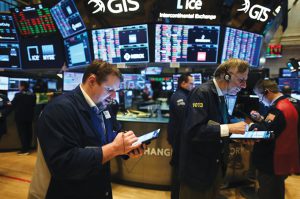BLOOMBERGÂ
The stock market was set for a rebound at the end of a chaotic week, with a rally in regional banks tempering data showing jobs resilience. Treasury yields rose with the dollar.
S&P 500 futures signalled the equity benchmark will climb after its longest losing streak since February. PacWest Bancorp soared, following a six-day selloff that saw its shares tumbling over 70%. Western Alliance Bancorp and First Horizon Corp, which were strongly hit in the previous session, also jumped. Apple Inc, the world’s most valuable company, rose on solid earnings.
The US added more jobs in April than expected and the unemployment rate fell back to a multi-decade low, highlighting the strength of the labour market despite growing economic headwinds.
S&P 500 futures rose as much as 0.6% in New York and Nasdaq 100 futures also climb 0.5%.
While futures on the Dow Jones Industrial Average rose 0.5%, the Stoxx Europe 600 rose 0.5% and the MSCI World index was little changed.
The Bloomberg Dollar Spot Index rose 0.1% and the euro fell 0.2% to $1.0986.
While the British pound was little changed at $1.2580, the Japanese yen declines 0.4% to 134.78 per dollar.
Bitcoin advances 0.1% to $28,924.43 and ether rose 1% to $1,897.09 and the yield on 10-year Treasuries advanced five basis points to 3.43%.
While Germany’s 10-year yield advanced 10 basis points to as much as 2.29%, Britain’s 10-year yield advanced 12 basis points to 3.78%.
West Texas Intermediate crude rose 3.3% to $70.80 a barrel and gold futures fell 1.1% to $2,032.80 an ounce.
Fed rate-hike pause no reason to buy stocks: BofA
The Federal Reserve may be signalling its willingness to pause rate hikes, but Bank of America Corp’s (BofA’s) Michael Hartnett says it’s not yet time to buy equities as outflows accelerate amid elevated inflation and recession fears.
Redemptions from global stock funds reached $6.6 billion in the week through May 3 — the most in more than two months, according to a note from the bank citing EPFR Global data. Inflows into cash funds surged to nearly $60 billion, while $11 billion entered bonds, the data show.
Hartnett — who correctly predicted the equity exodus last year — said that a “new structural bull market requires big Fed easing,†which in turn needs a “big recession.†With sticky price pressures and a resilient labour market preventing the Fed from pivoting to rate cuts, “sell the last rate hike,†the strategist wrote in the note dated.
After posting a second straight monthly gain in April, US stocks have pulled back in the early days of May amid prospects of higher-for-longer interest rates and slowing economic growth. The Fed hiked interest rates by 25 basis points and hinted it could be the last one for now. Market strategists have also warned about further declines in corporate earnings even as the first-quarter season has come in better than feared.
BofA’s Hartnett said the “big story of 2023†remains an “imminent recession,†which will damage the “Goldilocks†resilience of credit, technology stocks and homebuilders, while creating opportunities in so-called hard-landing assets such as oil, small caps and banks.
Investors will get the next clue on the health of the US labour market from the jobs data for April, after figures showed applications for unemployment benefits rose by the most in six weeks while continuing claims fell.
 The Gulf Time Newspaper One of the finest business newspapers in the UAE brought to you by our professional writers and editors.
The Gulf Time Newspaper One of the finest business newspapers in the UAE brought to you by our professional writers and editors.
